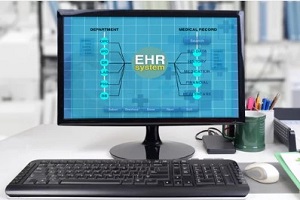Health-care systems are rapidly adopting electronic health records (EHRs) for managing patient information. Therefore, it’s essential to have a solid plan in place for proper implementation to minimize disruptions and maintain quality patient care. An EHR implementation plan is a detailed strategy for providers that outlines the steps involved in adopting the system and transitioning from paper-based to digital recordkeeping.
If you’re a provider wondering how to create your own strategy, you’re in luck. Today, we’re going to provide you with a comprehensive nine-step checklist to help you generate an effective EHR implementation plan that ensures a smooth transition, minimal disruption to operations, and improved patient care. On top of this, we’re also going to review how companies can assist you. For example, at Orases, we can streamline the EHR implementation process and make it easier than ever.
What Are Electronic Health Records (EHR)?
 EHRs are digital versions of a patient’s medical records containing all their health information in one place. EHRs are designed to make it easier for health-care providers to access and share patients’ medical information, leading to better coordination and improved patient care.
EHRs are digital versions of a patient’s medical records containing all their health information in one place. EHRs are designed to make it easier for health-care providers to access and share patients’ medical information, leading to better coordination and improved patient care.
EHRs can include a wide range of information, such as medical history, medications, allergies, laboratory results, imaging studies, and more. One of the key benefits of EHRs is that they can be accessed by multiple health-care providers across different locations, making it easier to coordinate care and provide patients with the right treatment at the right time.
In addition to improving patient care, EHRs also provide valuable insights for health-care practitioners and researchers. By analyzing large datasets of anonymized patient information, researchers can identify trends and patterns that can inform new treatments, preventative measures, and even larger public health initiatives.
Overall, EHRs are a crucial tool for the advancement of modern health care, providing a secure and efficient way to manage patients’ health information and improve the quality of care they receive.
EHR Implementation: An Overview
An EHR implementation plan involves the systematic planning and execution of integrating EHR software and components into a health-care organization’s operations. Implementation, in general, refers to integrating a software-based service or component into an organizational structure or an individual end-user’s workflow. Since an EHR implementation plan affects everyone involved in the health-care process, it requires a comprehensive organization-wide effort to go smoothly.
The Length Of An EHR Implementation
The duration of an EHR implementation is contingent on the context, as several variables can affect the time required. Consequently, the typical implementation timeline can vary based on the setting and product.
Ultimately, it takes time to establish a standard timeline for EHR implementation due to these factors and variations. Nonetheless, when developing an EHR implementation plan, involving experts in the process can help reduce the uncertainty surrounding timing. They can offer dependable estimates on the implementation duration and help guide the effort to completion.
The Steps Toward EHR Implementation
In addition to the general roadmap or checklist provided, it is essential to delve deeper into the individual steps involved in the EHR implementation process. Usually, the EHR implementation process comprises the following:
1. Build an EHR Implementation Team
To ensure a smooth EHR implementation process, assembling a strong team is crucial. This team can comprise various staff members, including physicians, nurses, medical assistants, and administrative staff.
These team members will be responsible for teaching their colleagues EHR skills and serving as a liaison to the implementation team, highlighting any challenges encountered. When building your team, consider including a lead super user, lead physician, and project manager, as they are essential roles.
The lead super user is the go-to person for all EHR-related inquiries and issues. This in-house expert creates templates, develops workflows, and establishes standard operating procedures to address any problems users face while using the system.
The lead physician aims to guide the organization through the EHR implementation process by bridging the gap between the system’s front-line users and the technical staff. Consider appointing a tech-savvy physician who welcomes the new process as the lead physician.
The project manager will be the primary contact between the EHR vendor and staff. This position will help everyone stay focused on the implementation timeline, track progress, and handle any user issues that may arise.
2. Prepare the Software for Implementation
 To prevent any HIPAA violations during the EHR implementation process, it’s vital to prioritize security measures. Therefore, your organization may need to conduct a HIPAA risk assessment to guarantee all necessary precautions are taken. You can also collaborate with your health IT vendor to confirm that the software is compliant with HIPAA regulations.
To prevent any HIPAA violations during the EHR implementation process, it’s vital to prioritize security measures. Therefore, your organization may need to conduct a HIPAA risk assessment to guarantee all necessary precautions are taken. You can also collaborate with your health IT vendor to confirm that the software is compliant with HIPAA regulations.
3. Figure Out Your Hardware Needs
The hardware choices you make for your EHR implementation can significantly affect your practice’s time and cost. For instance, equipping every room with a printer can save physicians significant time. Providing staff members with their own tablet or laptop can also save time logging in and out between patient interactions.
If you find the idea of handling all of this hardware-related work daunting, don’t worry. IT service companies like Orases can assist your practice in meeting your system hardware requirements by finding the right equipment at the best price. Moreover, many of these companies will install and troubleshoot the devices, relieving your office staff of the burden.
4. Factor in Patient Treatment Room Layout
When implementing an EHR program, the room layout can significantly impact patient engagement and satisfaction since electronic data entry is required. If staff and physicians face away from the patient while entering data, patients may feel neglected.
One effective solution is to use the triangle of trust room configuration. This involves arranging the patient, physician, and computer in a virtual triangle, allowing them to see each other. With this layout, the physician only has to turn slightly while entering data, making the patient feel seen and heard. Consider using semicircular-shaped desks in patient rooms or moveable carts to create a comfortable environment during appointments.
5. Begin the Data Transfer Process
When your hardware and software are ready, transferring data is the next critical step in EHR implementation. The first thing to determine is how to migrate the data from the previous record system to the new EHR. There are several ways to accomplish this step, including assigning existing staff or hiring additional/temporary staff to upload information to the new EHR.
To simplify things and make the process smoother, it’s vital to prepare a checklist of all the information to be entered into the EHR. Having a process like this in place will help ensure that no critical data is overlooked and that the entire transfer process is as seamless as possible.
6. Develop Implementation Workflows
When it comes to EHR implementation, establishing solid workflows is crucial. Doing so before implementation can reduce stress for your team and increase efficiency. Inefficient workflows and insufficiently trained staff can exacerbate issues during the implementation process. By establishing core needs to address, you can create workflows that maximize your team’s efficiency and ensure that the EHR implementation process goes smoothly.
7. Develop Downtime Contingencies
Preparing for the unexpected is key when it comes to implementing EHR technology. Anticipating potential glitches and developing a solid plan for handling them is crucial for minimizing disruption to patient care.
Consider scenarios like power outages or system-wide malfunctions that require IT support. You’ll want to create clear procedures that guide physicians and staff on contingencies for when EHR systems are down.
Providing electronic and paper copies of the procedures can increase staff confidence in handling EHR downtime. Some practices even store instructions in three-ring binders and securely on the cloud for quick and easy access.
8. Establish a Training Program
It’s crucial to provide extensive training to physicians and staff when implementing EHR. To ensure success, create a training plan covering all the knowledge and skills needed to use the EHR system successfully.
Starting slow is important. Give physicians and staff basic skills before launching, and let them use the program for at least a week to become familiar with it. After that, additional training can be introduced to increase skills and teach time-saving tricks.
Consider having super users in each specialty and role for ongoing training. They can share their knowledge with colleagues, become a resource for them, and keep the training going. Plan for ongoing training as users will identify modifications that can improve workflow, and the EHR will need to be updated with new and improved functionality.
It’s important to preserve the EHR vendor relationship and utilize IT support for data entry templates, forms, letters, clinical decision support rules, and order sets. Look for integration opportunities with other commonly used systems in the practice. Lastly, plan group training in advance to minimize disruption to the practice workflow.
9. Determine Implementation Rollout
 When it’s time to launch your EHR implementation plan, you can go with a sudden or incremental approach. With a sudden approach, the EHR system is rolled out for all patients and functions are operational on the same day. While this approach minimizes time spent managing paper records and the EHR system simultaneously, it can be very disruptive, and even small problems can seem monumental.
When it’s time to launch your EHR implementation plan, you can go with a sudden or incremental approach. With a sudden approach, the EHR system is rolled out for all patients and functions are operational on the same day. While this approach minimizes time spent managing paper records and the EHR system simultaneously, it can be very disruptive, and even small problems can seem monumental.
The incremental approach introduces EHR functions one at a time, making managing the disruption easier. For example, larger practices may implement the EHR first in specific sites or departments and then introduce the program to the rest of the organization later.
Ensure the Best EHR Implementation
Implementing an EHR system is a complex process that requires careful planning and execution. By following the nine-step checklist outlined above, you can have a successful EHR implementation that improves your organization’s efficiency and accuracy, improving patient care in the process. However, remember that each step is equally important, and missing any of them can lead to significant problems down the line.
At Orases, we make EHR implementation a seamless and beneficial transition for your organization. Our guidance can help your team successfully implement an EHR system and experience the benefits of improved patient care, increased efficiency, and enhanced data management. To learn more about how we can help your organization navigate the EHR implementation process, reach out to learn more today.






